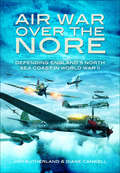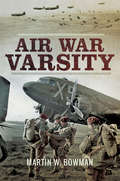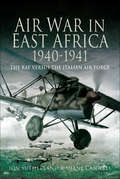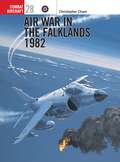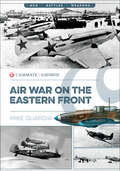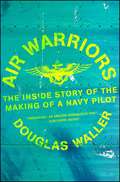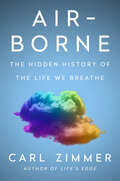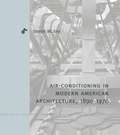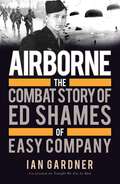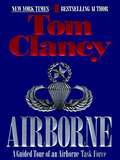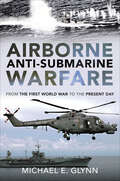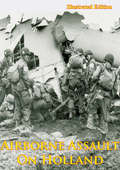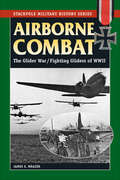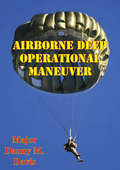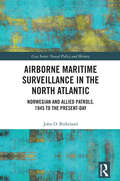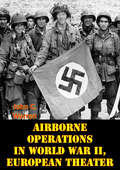- Table View
- List View
Air War Over the Nore: Defending England’s North Sea Coast in World War II
by Diane CanwellThe Battle of Britain and the Atlantic and the Blitz are invariably the focus of books and perceptions of the air war over and around Britain during the Second World War. Yet, it was Britains more exposed eastern flank, from the South Foreland in the south to Bridlington in the north that faced nearly six years of unrelenting attacks by the Luftwaffe, the Kriegsmarine and, amazingly, the Corpo Aereo Italiano based in Belgium. The Italians alone launched some 150 raids on England hitting Great Yarmouth, Clacton, Harwich, Deal, Ramsgate and a host of other targets.This book chronicles the air war around the east coast as its principle focus but also incorporate the joint operations mounted by both the Allies and the Axis forces. It looks at the preparations for invasion, the defense of vital convoys, the air defenses, the coastal blitz, ship and crew rescue and crucial docks and shipyards. With so much attention paid to the south coast, the air war over the east coast was often fought on a shoestring although it was the coast that lay closest to Germany. It was not a war of vast fleets of warships and submarines, it was conflict staged by aircraft and smaller raiding craft. It also saw the biggest mine-laying campaign in history and the largest battle fought between Axis E Boats and Allied Motor Torpedo Boats. As the tide turned in Britains favor, the east coast became the staging post of the great bomber offensives against enemy occupied Europe and Germany itself. Yet the raiding and attacks on the east coast continued culminating in air-launched V1 attacks and finally V2 strikes.
Air War Varsity
by Martin W. BowmanHere, Martin Bowman brings us the first book on Operation Varsity to include both British and US air and ground operations, as well as the US, British and Canadian paratroop and resupply missions, all presented together in one ambitious volume.Operation Varsity-Plunder, the last large-scale Allied airborne operation of World War II, was certainly no walk-over. Varsity was the airborne part, whilst Plunder represented the British amphibious operations by the British Second Army.The airlift consisted of 541 transport aircraft containing airborne troops and a further 1,050 troop-carriers towing 1,350 gliders. The American 17th Airborne Divisions C-46 Commando transports and Waco gliders joined the British 6th Airborne Division C-54s, C-47 transport aircrafts, Horsas and Hamilcar gliders to form an immense armada that stretched for more than 200 miles across the sky. The successful air attack involved more than 10,000 Allied aircraft and was concentrated primarily on Luftwaffe airfields and the German transportation system.The combination of the two divisions in one lift made this the largest single day airborne drop in history. In this impressive account, Martin Bowman weaves firsthand testimony and a compelling historical narrative together with a variety of photographic illustrations, many of which have never been published before, in order to create a complete and fascinating record of events as they played out in March 1945.
Air War Vietnam
by Martin W. Bowman"Showcasing specific aircraft and highlighting significant missions illuminates the skills and emotions of the men who flew the machines. Bowman does an excellent job recounting stories about battles in the air and decision-making on the ground." — The VVA Veteran Martin Bowman’s revealing narrative of the aerial conflict in South-East Asia, 1965-1972, which had its beginnings in 1 November 1955, engulfed Viêtnam, Laos, and Cambodia and only ended with the fall of Sàigòn on 30 April 1975 has resulted from decades of painstaking fact-finding as well as detailed correspondence with surviving aircrew incorporating a wealth of first-hand accounts, some never told before, supported by dozens of rare and unusual photographs. Together they describe in adrenalin-pumping accuracy the furious aerial battles of a long suffering and bitter war in South-East Asia and in particular the frontline action in the skies over Vietnam that will keep readers on the edge of their seats. They too will find a new and useful perspective on a conflict that cost the Americans 58,022 dead and brought the USA worldwide condemnation for its role in Southeast Asia. Nearly 2,500 Americans remained ‘missing’. This work serves as a tribute to the courageous pilots who flew the F-104 Starfighter in the ‘Widowmakers’ war and B-52 bomber crews on ‘Arc Light’ ‘Linebacker II’ strikes and the eleven days of Christmas which ultimately ended the aerial campaign against North Viêtnam. And as well, strike aircraft such as the USAF F-4 Phantom and the F-105 ‘Thud’ and the US Navy carrier-borne jet and propeller-driven strike aircraft and the Americans’ sworn enemy, the North Việtnamese MiG fighters, feature large, from ‘Rolling Thunder’ onwards. Equally, the Hueys and Chinooks and other notable work horses that participated on combat assaults or Ash & Trash missions and transports like the C-130 ‘Herky-Bird’, C-123 Provider, Caribou and Viêtnamese C-47 - the ‘Haulers On Call’ - that performed sterling service during the gruelling air campaign are not forgotten either. Here, at first hand, are their stories which also include some of the less publicised American forces like the pilots and crewmen who flew the Bird Dogs and all manner of helicopters as well as the largely forgotten Australian and New Zealand Air Force units and the Anzac Battalions whose valuable contributions are too often overlooked. So too is the cost in human misery, death and destruction.
Air War in East Africa, 1940–41: The RAF Versus the Italian Air Force
by Diane Canwell Jon SutherlandThis little known campaign against the Italian invasion of British Somalia was bravely fought by a small force of elderly RAF and Commonwealth aircraft against almost overwhelming odds. This, against a backdrop of Britains meager assets being in demand in the much more prominent and important theatres such as Egypt and, of course, at home during the height of the Battle of Britain and the Blitz.The history starts with the Italians use of airpower and gas against the spear-armed Abbysinnians in 1936. In August 1940 the Italians attacked and overwhelmed British Somalia and under air cover the British evacuated to Aden. The Allies fought many air battles with the better equipped invaders and flew dangerous reconnaissance missions in preparation for the major offensives in 1941.On the Northern Front, the first phases see aggressive air patrols and Allied reinforcements arriving from Egypt. They attacked towards Agordat pushing deep into Eritrea from the Sudan. Meanwhile to the south the South African Air Force and ground forces attacked into Italian Somalia during January and February 1941. In March the allies attacked Keren and the Italians finally surrendered. The final allied air strikes against Asmara and Massawa led to the final collapse of Italian resistance in May 1941. The campaign in Ethiopia saw General Cunningham's force advances 1,725 miles from Kenya in 53 days to reach the Ethiopian capital Addis Ababa and liberating it on April 6 1941. However, the conflict was still not over there was continued resistance from 7,000 Italian troops and air operations continued against them until their surrender in September 1943.The book includes the experiences of the men who flew the outdated aircraft of the RAF and the SAAF in the campaign and includes many quotes and incidents from both Allied and Italian pilots.
Air War in the Falklands 1982
by Mark Rolfe Chris ChantThe Falklands War (1982), fought between the United Kingdom and Argentina for the possession of the Falkland Islands, was probably the last 'colonial' war that will ever be undertaken by the British. This book shows how the key to British success was the speed with which the British gained and then maintained air superiority over the islands and the waters around them with their small force of Sea Harrier STOVL warplanes, which operated from two aircraft carriers. Though subsonic, the Sea Harrier and its Sidewinder AAM were a combination altogether superior to Argentina's mix of supersonic and subsonic warplanes with older weapons, and this advantage was emphasised by the significantly greater tactical acuity of the British pilots. The Argentine pilots fought with considerable piloting skill and enormous courage, and scored a number of stunning successes against British warships, but ultimately they could not prevent the British landing and the following land campaign that resulted in complete Argentine defeat.
Air War on the Eastern Front (Casemate Illustrated #Cis0019)
by Mike GuardiaA pictorial history of Nazi Germany’s entire air campaign against the Soviet Union on the Eastern Front in World War II.The Red Air Force versus the Luftwaffe in the skies over Eastern Europe. June 1941: Having conquered most of Western Europe, Adolf Hitler turned his attention to the vast Soviet Union. Disregarding his Non-Aggression Pact with Joseph Stalin, Hitler launched Operation Barbarossa, a full-scale invasion of the Soviet homeland . . . aimed squarely at Moscow.In the skies over Russia, the battle-hardened airmen of the Luftwaffe made short work of the Red Air Force during opening days of Barbarossa. To make matters worse, Stalin had executed many of his best pilots during the perennial “purges” of the 1930s. Thus, much of the Red Air Force was destroyed on the ground before meeting the Luftwaffe in the skies. By 1944, however, the Soviet airmen had regained the initiative and fervently wrested air superiority from the now-ailing Axis Powers.“Will be of great interest to both modelers and aircraft historians alike.” —AMPS Indianapolis“This slim survey provides a quick, convenient intro to the deadly totalitarian duel. Make it a launchpad to further study of Eastern Front air combat in WWII.” —Cybermodeler“The prose is smooth and provides a top-level look at WWII German and Soviet air warfare.” —Historical Miniatures Gaming Society
Air Warfare in the Missile Age
by Lon O. NordeenLon O. Nordeen has completely updated his 1985 chronicle of military aviation's evolving role in warfare, now covering the major conflicts of the past four decades. He presents the historical and political background of each conflict and includes in-depth discussions of the aircraft, weapons, tactics, training, new systems, and other factors that influenced the outcome of each war. New and existing chapters have been enhanced with information based on recently declassified material--especially regarding Vietnam--and new sources in Egypt, Israel, and the former Soviet Union. As "smart" bombs have become more successful in reducing the risks for pilots and frontline troops, air-missile warfare has become the central player in military conflicts. Air Warfare in the Missile Age, Second Edition, is a valuable resource for understanding the evolution of modern air warfare.
Air Warriors: The Inside Story of the Making of a Navy Pilot
by Douglas WallerVeteran journalist and author of The Commandos Douglas Waller chronicles his rare and intimate experience with the training program for Navy pilots in this &“engrossing saga that will likely become an unofficial recruiting tool for naval aviation&” (Publishers Weekly). Waller, who was granted permission to participate in the pilots&’ grueling training regime, has written an absorbing behind-the-scenes account of the physical and psychological trials endured by the most specialized group of pilots in military history. From his bird&’s-eye view in the passenger&’s seat, Waller follows pilot trainees through two years of intense preparation. He offers vivid illustrations from the fray: hair-raising aerial dogfights; stomach-swallowing dive-bombing runs; high-speed tactical maneuvers grazing the desert floor; and numerous nerve-twisting aircraft carrier takeoffs and landings. In addition to his own experiences and those of the group of trainees he joins, his research is based on interviews with hundreds of other students and their instructors. Hurtling through the air at death-defying speeds, these pilots-in-training struggle to maintain their composure while withstanding conditions that are designed to challenge them to the very limits of human endurance. Waller&’s deftly drawn portraits of the men and women he encounters in this singular culture of elite pilots are as satisfying as his adventure narrative. The pilots, whose grit, determination, and mental agility operate on an elevated threshold, come into sharp focus behind Waller&’s keen lens: their aspirations, awe inspiring. Air Warriors combines an examination of the modern Navy, recovering from past sex scandals, with a portrayal of a privileged cadre of men and women whose ambition and commitment coexist within a tightly knit group. Waller is able to capture images of these pilots training, living, and fighting with an acuity and intelligence that are often absent from Hollywood and television treatments of this diverse and fascinating subculture. Air Warriors takes us inside the cockpit and behind closed doors for the real story of the making of a Navy pilot.
Air and Darkness (The Books of the Elements)
by David DrakeAir and Darkness, an intriguing and fantastic adventure, is both an independent novel and the gripping conclusion of the Books of the Elements, a four-volume set of fantasies set in Carce, an analog of ancient Rome by David Drake.Here the stakes are raised from the previous novels in an ultimate conflict between the forces of logic and reason and the forces of magic and the supernatural. During the extraordinary time in which this story is set, the supernatural is dominant. The story is an immensely complex journey of adventure through real and magical places. Corylus, a soldier, emerges as one of the most compelling heroic figures in contemporary fantasy. Battling magicians, spirits, gods, and forces from supernatural realities, Corylus and his companions from the family of the nobleman Saxa-especially Saxa's impressive wife Hedia, and his friend (and Saxa's son) Varus-must face constant deadly and soul-destroying dangers, climaxing in a final battle not between good and evil but in defense of logic and reality.At the Publisher's request, this title is being sold without Digital Rights Management Software (DRM) applied.
Air-Borne: The Hidden History of the Life We Breathe
by Carl ZimmerThe fascinating, untold story of the air we breathe, the hidden life it contains, and invisible dangers that can turn the world upside downEvery day we draw in two thousand gallons of air—and thousands of living things. From the ground to the stratosphere, the air teems with invisible life. This last great biological frontier remains so mysterious that it took over two years for scientists to finally agree that the Covid pandemic was caused by an airborne virus.In Air-Borne, award-winning New York Times columnist and author Carl Zimmer leads us on an odyssey through the living atmosphere and through the history of its discovery. We travel to the tops of mountain glaciers, where Louis Pasteur caught germs from the air, and follow Amelia Earhart and Charles Lindbergh above the clouds, where they conducted groundbreaking experiments. We meet the long-forgotten pioneers of aerobiology including William and Mildred Wells, who tried for decades to warn the world about airborne infections, only to die in obscurity.Air-Borne chronicles the dark side of aerobiology with gripping accounts of how the United States and the Soviet Union clandestinely built arsenals of airborne biological weapons designed to spread anthrax, smallpox, and an array of other pathogens. Air-Borne also leaves readers looking at the world with new eyes—as a place where the oceans and forests loft trillions of cells into the air, where microbes eat clouds, and where life soars thousands of miles on the wind.Weaving together gripping history with the latest reporting on Covid and other threats to global health, Air-Borne surprises us on every page as it reveals the hidden world of the air.
Air-Conditioning in Modern American Architecture, 1890–1970 (Buildings, Landscapes, and Societies #11)
by Joseph M. SiryAir-Conditioning in Modern American Architecture, 1890–1970, documents how architects made environmental technologies into resources that helped shape their spatial and formal aesthetic. In doing so, it sheds important new light on the ways in which mechanical engineering has been assimilated into the culture of architecture as one facet of its broader modernist project.Tracing the development and architectural integration of air-conditioning from its origins in the late nineteenth century to the advent of the environmental movement in the early 1970s, Joseph M. Siry shows how the incorporation of mechanical systems into modernism’s discourse of functionality profoundly shaped the work of some of the movement’s leading architects, such as Dankmar Adler, Louis Sullivan, Frank Lloyd Wright, Ludwig Mies van der Rohe, Gordon Bunshaft, and Louis Kahn. For them, the modernist ideal of functionality was incompletely realized if it did not wholly assimilate heating, cooling, ventilating, and artificial lighting. Bridging the history of technology and the history of architecture, Siry discusses air-conditioning’s technical and social history and provides case studies of buildings by the master architects who brought this technology into the conceptual and formal project of modernism.A monumental work by a renowned expert in American modernist architecture, this book asks us to see canonical modernist buildings through a mechanical engineering–oriented lens. It will be especially valuable to scholars and students of architecture, modernism, the history of technology, and American history.
Air-Conditioning in Modern American Architecture, 1890–1970 (Buildings, Landscapes, and Societies)
by Joseph M. SiryAir-Conditioning in Modern American Architecture, 1890–1970, documents how architects made environmental technologies into resources that helped shape their spatial and formal aesthetic. In doing so, it sheds important new light on the ways in which mechanical engineering has been assimilated into the culture of architecture as one facet of its broader modernist project.Tracing the development and architectural integration of air-conditioning from its origins in the late nineteenth century to the advent of the environmental movement in the early 1970s, Joseph M. Siry shows how the incorporation of mechanical systems into modernism’s discourse of functionality profoundly shaped the work of some of the movement’s leading architects, such as Dankmar Adler, Louis Sullivan, Frank Lloyd Wright, Ludwig Mies van der Rohe, Gordon Bunshaft, and Louis Kahn. For them, the modernist ideal of functionality was incompletely realized if it did not wholly assimilate heating, cooling, ventilating, and artificial lighting. Bridging the history of technology and the history of architecture, Siry discusses air-conditioning’s technical and social history and provides case studies of buildings by the master architects who brought this technology into the conceptual and formal project of modernism.A monumental work by a renowned expert in American modernist architecture, this book asks us to see canonical modernist buildings through a mechanical engineering–oriented lens. It will be especially valuable to scholars and students of architecture, modernism, the history of technology, and American history.
Air-Ground Teamwork On The Western Front - The Role Of The XIX Tactical Air Command During August 1944: [Illustrated Edition] (Wings At War #5)
by AnonIllustrated with 6 maps and 1 Illustrations.Air-Ground Teamwork on the Western Front describes close air support and battlefield interdiction in action. A single, month-long campaign-the famous thrust across northern France in August 1944 of Gen. George S. Patton's Third Army and Maj. Gen. O. P. Weyland's XIX Tactical Air Command-became a model for close cooperation between army and aviation forces in future conflicts. This day-by-day, blow-by-blow account shows how the ground forces raced forward, frequently twenty miles per day, because friendly air power protected their flanks, shielded them from the Luftwaffe, and devastated the opposition in front of them.Originally published shortly after key air campaigns, the Wings at War series captures the spirit and tone of America's World War II experience. Eyewitness accounts of Army Air Forces' avia
Air-Launched Doodlebugs: The Forgotten Campaign
by Peter C. SmithThe V 1, or Doodlebug or Flying-bomb came into use in June 1944 and, together with the V 2 Rocket, was Hitlers final hope in face of the advancing Allied forces sweeping across Europe towards Germany. Of the 8,000 that were launched within the first 80 days, some 2,300 reached the London area where they caused more death and destruction to its population and buildings. As the front line moved eastwards, many of the ground-based launch ramps became denied to the German forces and the modest range of the missile meant that other means of launching must be considered to continue the threat. An air-launching system, utilizing the Luftwaffes Heinkel 111 bomber, was developed and operated by the newly formed Kampfgeschwader units. This posed a dramatic new threat to the UK because the V 1s effective range was considerably increased and its mobile firing point offered a much greater target area when fired from an aircraft flying over the North Sea. This is the story of the development and operation of this new form of attack and also of the Allied reaction and defense-measures taken to minimize damage.
Air-To-Ground Battle For Italy [Illustrated Edition]
by Michael MccarthyIncludes over 20 Illustrations.The story of a young fighter pilot from basic training through the end of the war in Europe, this short memoir is a welcome addition to the literature of World War II aviation. It is noteworthy for a number of reasons. It illuminates the world of tactical aviation, which has taken a backseat to stories of strategic bombing and air superiority combat...Perhaps most importantly, it combines the immediacy of contemporary impressions with the reflections possible after a long and distinguished Air Force career.Michael C. McCarthy was part of the first wave of young Americans who joined up in the aftermath of Pearl Harbor. His peer group...arrived at the North African front in the spring of 1943 as part of an enormous bow wave of American human and industrial mobilization. His account of flight training is one of the best available anywhere and captures--in microcosm--the huge undertaking required to produce thousands of highly trained combat crews for the Allied war effort. McCarthy and his comrades joined the veterans of the prewar Army Air Corps who had held the line from El Alamein through the desperate battles around Kasserine Pass. McCarthy spent his entire war with the 57th Fighter Group, first flying the Curtiss P-40 Warhawk and later the powerful Republic P-47 Thunderbolt.His battlefield was not in the stratosphere over the Third Reich...His war began with a ferry flight from Lagos, Nigeria, to Cape Bon, Tunisia, after the Axis defeat in North Africa; through the invasion of Sicily in July 1943 and the long slog up the Italian peninsula in 1943-1944 including landings at Salerno, Anzio, and the battles around Monte Cassino, with a brief detour in support of the invasion of southern France. Their unglamorous business was conducting interdiction and close air support, part of a lengthy and costly combined-arms effort to leverage the Germans out of their powerful defensive positions on the Italian peninsula.
Airborne
by Ian GardnerCol. Ed Shames is that rare man who can call himself a true warrior. A member of Easy Company of Band of Brothers fame, Shames saw combat in some of the most ferocious battles of WW2. From jumping behind the lines of Normandy on D-Day with the 101st Airborne Division, to the near victory of Operation Market Garden, to the legendary stand at Bastogne during the Battle of the Bulge, Shames fought his way across Europe and into Germany itself.In Airborne Shames and writer Ian Gardiner (Tonight We Die as Men) tell the gripping true story of what it was like to be at the spear point of WW2 in Europe. Neither the book nor TV series of Band of Brothers ever showed the real Ed Shames. Although he started as a private, combat soon forged Shames into a tough and inspired leader who would win a battle field commission in Normandy. Seemingly to always be where the fighting was, his two goals were to prevail in each fight with the Germans, and to keep his men alive. "Shames, you are the meanest, roughest son of a bitch I've ever had to deal with. But you brought us home," was the highest compliment he received from one of his men.Even though he was wounded in the Ardennes, Ed Shames never stopped fighting until Germany surrendered and the war was won. He has never stopped being a warrior.
Airborne
by Tom ClancyThey are America's front lines--serving proudly in forward areas around the world. Representing the very best from the Army and Air Force, the Airborne Task Force is an unstoppable combination of manpower and firepower. Now, Tom Clancy examines this elite branch of our nation's armed forces. With pinpoint accuracy and a style more compelling than any fiction, the acclaimed author of Executive Orders delivers an fascinating account of the Airborne juggernaut--the people, the technology, and Airborne's mission in an ever-changing world... * Two Tom Clancy "mini-novels"--real world scenarios involving the airborne task force * Airborne's weapons of the 21st century, including the Javelin anti-tank missile, the fiber-optically guided N-LOS fire support system, and the Joint Strike Fighter * 18 weeks: Life in an Airborne Alert Brigade * Exclusive photographs, illustrations, and diagrams PLUS: An in-depth interview with the incoming commander of the 18th Airborne Corps, General John Keen
Airborne Anti-Submarine Warfare: From the First World War to the Present Day
by Michael GlynnThis military history explores more than a century of aerial submarine hunting, from WWI through the Cold War and beyond. U. S. Navy veteran Michael Glynn served as a submarine hunting pilot. Now he chronicles the evolution of this unique combat role from the Great War through the Battle of the Atlantic in World War II and on to secret Cold War confrontations. He traces the parallel evolution of both aircraft and submarine as each side tries to gain advantage. Through his expert analysis, Glynn distills complicated oceanography, operations analysis, and technical theory, helping the reader understand how complex weapons and sensors function. He also examines submarine hunts in action, showing how theory and practice work together to help aviators detected their targets.
Airborne Assault On Holland [Illustrated Edition] (Wings At War #4)
by AnonIllustrated with 4 maps and 2 Illustrations.Airborne Assault on Holland highlights the role of air power as the Allies attempted to penetrate German defenses at the Siegfried Line. The work reflects the circumstances of the time and the desire to find good even in unfortunate circumstances and should be read with this in mind. Allied airborne paratroops and glider-borne units converged on Arnhem. Unfortunately, stiff German resistance forced their eventual withdrawal; Allied tactical air power prevented even heavier friendly losses, but could not turn defeat into victory. This boldly conceived operation involved the Eighth and Ninth Air Forces in a variety of missions: troop transport, fighter escort, flak neutralization, air cover, and resupply of ground forces.
Airborne Combat: The Glider War / Fighting Gliders of WWII (Stackpole Military History Series)
by James E MrazekStories of WWII&’s elite glider troops and their combat operations, including Eben Emael, Normandy, Bastogne during the Battle of the Bulge, and more. Long pursued by civilian thrill seekers and dare devils, airborne gliding came of age during World War II as one of that conflict&’s most dangerous combat operations. The armed forces of Axis and Allied nations developed gliders—wooden aircraft that bursts of flak could shred and a poor landing could smash—and flew them into battle at Eben Emael, Crete, Normandy, Arnhem, and Bastogne. James E. Mrazek&’s riveting account brings to life both the men who carried out these perilous missions and the gliders that proved vital to the success of airborne attacks.
Airborne Deep Operational Maneuver
by Major Danny M. DavisThe purpose of this paper is to answer two questions. The first question is: Is it feasible to use airborne forces to penetrate enemy airspace and to conduct a vertical envelopment to effect deep operational maneuver? If it is feasible, what are the employment options available for the use of such an airborne force in the conduct of a modern military campaign? To examine these questions, the paper begins with some definitions to provide a common frame of reference. The use of airborne forces in World War II is next examined to determine if the use of airborne forces to effect deep operational maneuver is historically feasible. Next, the contemporary threat is discussed as it is relevant to the employment of airborne forces in a modern context. Next, the feasibility of the use of airborne forces with some limitations to conduct deep operational maneuver is established in the context of the maneuver, firepower, and protection aspects of the combat power model. Next, the theory of deep operations and the use of airborne forces to conduct these kinds of deep maneuvers is examined in the theories of Clausewitz, Jomini, Tukhachevskiy, Triandafillov, and Simpkin. Next, six employment options for the use of airborne forces to conduct deep operations in a modern context are deduced. They are: (1) an airborne force can be used to create a second front within a theater of operations; (2) an airborne force can be used to operationally contain an enemy force targeted for destruction within a theater of operations; (3) an airborne force can be used to seize a "bridgehead"...; (4) an airborne force can conduct coups de main against high value targets within a theater of operations; (5) an airborne force can conduct light operations in a theater of operations to disrupt and disorganize the enemy's rear facilities and networks and have a cumulative operational impact; and (6) an airborne force can conduct expeditionary operations to achieve political, strategic, and operational aims
Airborne Invasion Of Crete, 1941
by Anon Brigadier General Sherman MilesThe fascinating story of the first major airborne operation in history, the swift, bloody tale of the Fallschirmjäger of the German Wehrmacht as they battled and won the battles to capture the island of Crete.The drama of Crete marks an epic in warfare. The concept of the operation was highly imaginative, daringly new. Combat elements drawn from Central Europe moved with precision into funnel shaped Greece. Here they re-formed, took shape as a balanced force, were given wings. The operation had the movement, rhythm, harmony of a master’s organ composition. On 20 May and succeeding days this force soared through space; its elements broke over Crete in thundering crescendos - all stops out. For the first time .in history airborne troops, supplied and supported, by air, landed in the face of an enemy, defeated him. For the first time an air force defeated a first-rate Navy, inflicted such staggering losses that the fleet was ordered back to Alexandria three days after the battle started.
Airborne Landing to Air Assault: A History of Military Parachuting
by Nikolaos TheotokisA complete history of paratroopers and their role in modern war, including a glossary and photos.Many books have been written about military parachuting, particularly about famous operations like Crete and Arnhem in the Second World War and notable units like the British Parachute Regiment and the US 101st Airborne Division, but no previous book has covered the entire history of the use of the parachute in warfare. In this valuable study, Nikolaos Theotokis traces in vivid detail the development of parachuting over the last hundred years and describes how it became a standard tactic in twentieth-century conflicts. As well as depicting a series of historic parachute operations all over the world, he recognizes the role of airmen in the story, for they were the first to use the parachute in warfare when they jumped from crippled planes in combat conditions.Adapting the parachute for military purposes occurred with extraordinary speed during the First World War and, by the time of the Second World War, it had become an established technique for special operations and offensive actions on a large scale. The range of parachute drops and parachute-led attacks was remarkable, and all the most dramatic examples from the world wars and lesser conflicts are recounted in this graphic and detailed study. The role played by parachute troops as elite infantry is also a vital part of the narrative, as is the way in which techniques of air assault have evolved since the 1970s.
Airborne Maritime Surveillance in the North Atlantic: Norwegian and Allied Patrols, 1945 to the Present-day (Cass Series: Naval Policy and History)
by John O. BirkelandThis book offers a comprehensive examination of historical Norwegian and allied airborne maritime surveillance operations in the North Atlantic, after World War II until the present.Russia’s resurgent naval and submarine activity in the High North needs to be closely observed. Norway, together with her closest allies, have monitored such activity in the High North since the end of World War II. One of the key instruments in that effort has been Maritime Patrol Aircraft (MPA), with their Anti-Submarine Warfare (ASW) capabilities. However, after the Cold War, in many nations an atrophy took place within the MPA communities of knowledge, resources, and experience with airborne ASW. This occurred just as the concept of intelligence, surveillance and reconnaissance (ISR) came to play an increasingly important role in modern warfare, but without sufficient attention being paid to the specific challenges of maritime airborne surveillance and reconnaissance. This book addresses that gap and examines the entwined evolution of airborne maritime surveillance by MPA and ASW in the High North, both during and after the Cold War, with the main focus being on Norway. The discussion identifies the fundamental ‘building blocks’ of these historical surveillance operations through a portrayal of the development of airborne surveillance and reconnaissance operations. These building blocks are then applied to make recommendations for the future for maritime surveillance in the High North.This book will be of much interest to students of naval history, strategic studies, intelligence studies, Nordic studies and International Relations.
Airborne Operations In World War II, European Theater [Illustrated Edition]
by Dr John C. WarrenIncludes 12 maps, 12 photos and 2 charts.THE seminal study of the Allied large scale airdrops of the Second World War in the European Theater."The first combat airborne missions in history were flown by the Germans in 1940. Recognizing the possibilities of such operations, the British and Americans followed suit. The first British mission was flown in February 1941, and the first American mission was flown from England to Oran, Algeria, on 8 November 1942 as part of the Anglo-American invasion of North Africa. Other, later missions, principally in the Mediterranean region, provided the American troop carriers with an apprenticeship in airborne warfare. However, until the summer of 1944 no force larger than a reinforced regimental combat team was flown into action in any Allied mission. In World War II the only Allied airborne operations employing more than one division took place in the invasion of Normandy, the unsuccessful attempt to win a bridgehead across the Rhine at Arnhem, and the successful crossing of the Rhine at Wesel. Consequently the study of airborne missions in the European Theater of Operations is of particular importance for the light it throws on the planning and performance of large-scale airborne assaults."
